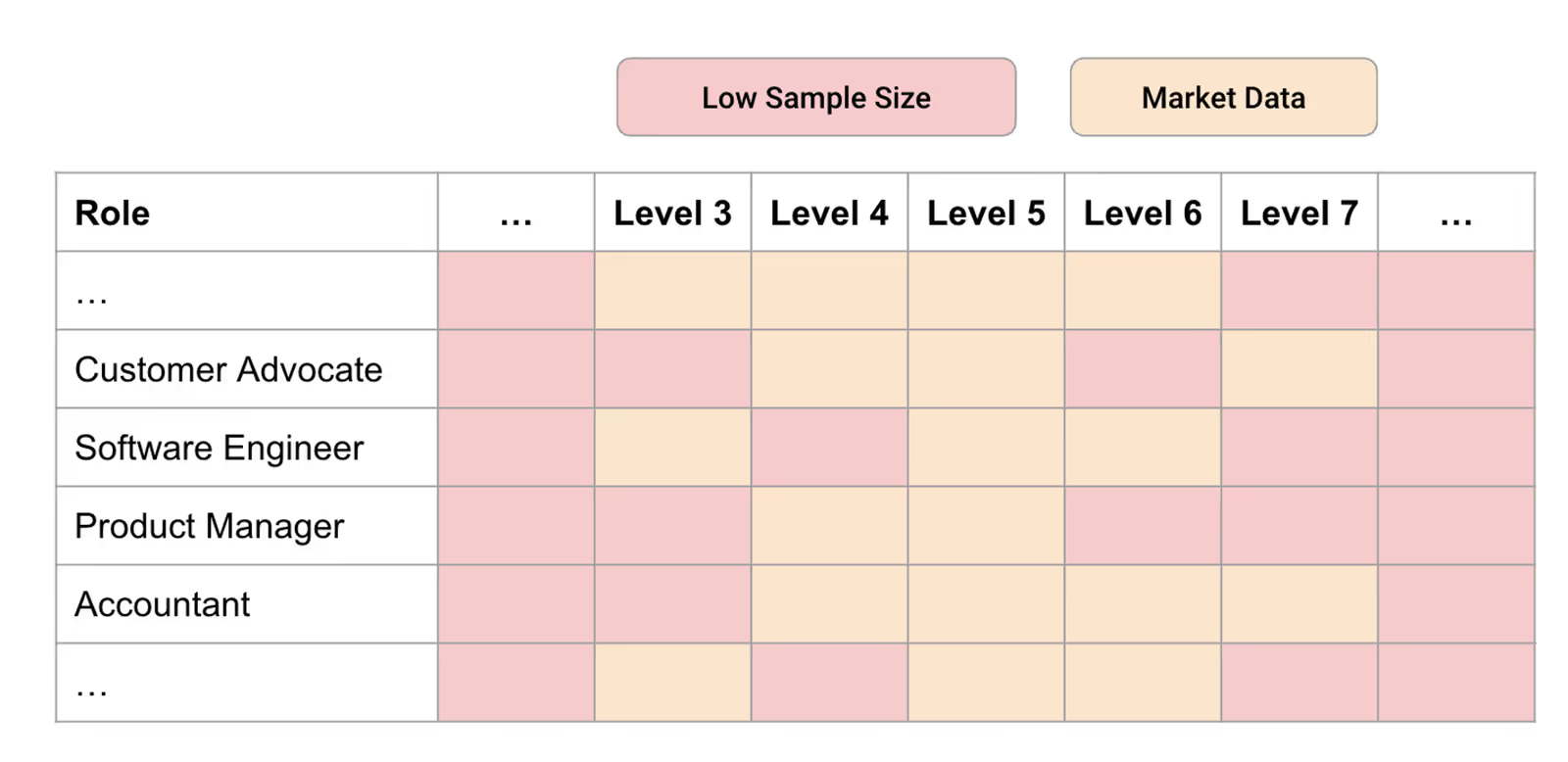Why Job Grade Levels Matter in Pay Planning?
%20(36).avif)
Two employees, same title, similar skills—but a 25% pay difference. Not an outlier. A symptom.
The real issue isn't always the number on the paycheck. It's the lack of structure behind it. When compensation feels arbitrary, even well-paid employees begin to question their worth.
"You don't lose people to pay better. You lose them to perceived unfairness."- Krish Shankar, Ex-CHRO, Infosys
This is where job grade levels come in. They're the invisible framework that supports fair and scalable compensation systems. While most employees never see the grade structure directly, they feel its impact every day—in how their pay compares to that of their peers, how raises are determined, and whether career growth feels achievable or impossible.
Getting job grade levels right is the foundation that makes everything else work. This guide will show you how to build and maintain grade structures that create pay transparency and trust in your compensation strategy.
What Are Job Grade Levels or Employee Grade Levels?
Employee or job grade levels are a systematic way to classify every job in your organization based on its relative value and complexity. Each grade represents a distinct tier of responsibility, required expertise, and decision-making authority that spans across all departments and functions.

Here's how it works in practice:
A Senior Software Engineer and a Senior Marketing Manager might both sit at Grade 7, even though they work in entirely different functions, because their roles require similar levels of expertise, scope of responsibility, and impact on business outcomes.
The grade system looks past job titles to focus on the underlying value each position brings to the organization.
Grade levels aren't job titles—those are what appear on business cards and org charts. They're not salary bands either, though they determine which compensation range applies to each role. Instead, they create a unified framework for evaluating and compensating work across your entire organization.
Most mature organizations use 10 to 15 grade levels that span from entry-level positions to executive roles, encompassing all departments and geographies under a single structure. This creates consistency in compensation decisions, whether you're hiring in your headquarters or a remote office, whether it's for technical roles or business functions.
Real-World Example: How Buffer Built Its Salary Formula with Grade Levels
When Buffer decided to make every employee's salary public, they needed a compensation system that could withstand complete transparency and public scrutiny. Their solution was a comprehensive grade-based framework that has evolved over a decade of real-world testing.

Buffer's current system centers on what they call "Buffer Benchmarks"—essentially a structured grid showing every role at every level across the organization. Think of it as a master salary map where each intersection of role and level has a predetermined compensation range. This grid spans six experience levels, from entry-level contributors to senior leadership positions.

Here's how their formula works in practice:
- Every salary starts with market data from companies of similar size and stage, explicitly filtered for their industry
- However, rather than simply copying market rates, Buffer applies its adjustments. They anchor everything to Level 5 data (mid-career professionals) because that's where market data tends to be most reliable and consistent.
- From that anchor point, they create standardized percentage increases between levels. A Level 4 professional might earn 85% of the Level 5 benchmark, while a Level 6 professional earns 115%
- These percentages stay consistent across all functions, which prevents the arbitrary pay differences that often emerge when each department negotiates its structure.
The transparency aspect goes beyond just publishing numbers. Buffer maintains three separate spreadsheets that anyone can examine: raw market data, their adjusted benchmarks, and actual employee salaries. This separation allows people to see not just what everyone earns, but exactly how those numbers were calculated.
The results have been significant. Over their decade of transparent salaries, Buffer reports higher employee trust, reduced turnover, and stronger diversity outcomes. When pay decisions follow a clear, visible framework rather than closed-door negotiations, unconscious bias gets much harder to hide.
They've also found that candidates are more likely to accept offers because they understand precisely how compensation works and can see their potential career progression.
Most importantly, Buffer's approach demonstrates that grade levels aren't just administrative convenience—they're the foundation that makes fair, transparent compensation possible at scale.
Why Job Grade Levels Are the Foundation of A Compensation Strategy?
“Most of the attrition is not because of lack of pay, but because people don't understand how pay works." - Puneet Swani, Senior Partner at Aon
This explains why grade levels have become essential for modern compensation strategy—they create the structure that makes pay decisions understandable and defensible.
One advantage of using a pay grade system in planning employee compensation is that it aligns pay structures directly to role complexity and organizational value. Instead of arbitrary salary decisions based on negotiation skills or manager preferences, grade levels ensure that roles requiring similar expertise and carrying comparable responsibility receive equivalent compensation ranges.
A senior analyst in finance and a senior analyst in marketing might have different day-to-day tasks. Still, if both require similar education, experience, and decision-making authority, they belong in the same grade with similar pay potential.
Key benefits of grade-based compensation include:
- Reduced bias in hiring and merit cycles - When every role has a predetermined grade and associated salary range, hiring managers can't unconsciously offer different starting salaries to candidates based on personal characteristics unrelated to job performance. During annual reviews, merit increases follow structured guidelines rather than subjective impressions.
- Consistent global and regional planning - Companies can maintain unified job architectures while adjusting salary ranges for local market conditions. A Grade 7 software engineer in San Francisco and one in Austin have the same role complexity and career level—the grade system ensures this equivalence is recognized even when dollar amounts differ for cost-of-living reasons.

- Foundation for pay transparency compliance - When job postings require salary ranges, those ranges must be based on defensible, systematic job evaluations rather than guesswork. Grade levels provide a structured approach that can withstand legal scrutiny and demonstrate a genuine commitment to pay equity.
- Support for internal mobility and talent planning - Grade levels create clear career pathways that enable employees to see exactly what skills and responsibilities they need to develop to reach the next level. At the same time, HR teams can identify skill gaps and succession planning needs across the organization's entire career architecture.
How Job Grade Levels Shape Pay Structures?
Job Grade levels don't exist in isolation—they're the foundation that determines how every element of your compensation program fits together.
The most direct connection is how grades map to salary bands. Each grade level corresponds to a specific salary range with defined minimum, midpoint, and maximum values. For example, Grade 5 might span $65,000 to $85,000, while Grade 6 covers $78,000 to $102,000. These ranges create a logical progression, where higher grades offer a meaningfully higher earning potential, but with enough overlap to allow high performers to earn competitively before promotion.
Beyond base salary, grade levels shape the broader compensation package. Higher grades typically unlock greater bonus eligibility—a Grade 3 employee might be eligible for a 5% annual bonus, while Grade 7 professionals could earn up to 15%.
Equity grants often follow the same pattern, with senior grades receiving larger stock option pools or restricted stock awards. Even benefits can vary by grade, with higher levels gaining access to additional perks, such as executive coaching or enhanced health coverage.

Grade levels also enable location-based adjustments while maintaining internal equity across your organization. A Grade 6 marketing manager in New York and one in Denver have equivalent roles and career levels, even if their actual dollar amounts differ to reflect local market conditions. The grade system ensures this equivalence is preserved—both employees sit at the same level in your career architecture and have similar advancement opportunities.
Perhaps most practically, grade levels improve clarity during key HR processes. When hiring, you can immediately identify the appropriate salary range for any role based on its grade. During promotion discussions, the grade framework indicates the increase in responsibility and compensation that the move represents.
For benchmarking exercises, you can compare your Grade 5 roles against market data for similar-level positions, ensuring your ranges stay competitive without losing internal logic.
This systematic approach transforms compensation from a collection of individual decisions into a coherent strategy that employees can understand and trust.
Top Mistakes to Avoid When Defining a Grade System in Corporate
Building an effective grade system requires careful planning and ongoing attention. Here are the most common mistakes and challenges that can undermine your compensation strategy before it even gets started.
Overcomplicating or under-defining grades
The biggest mistake is creating a system that's either impossibly complex or frustratingly vague. Some organizations build 25+ grade levels with microscopic distinctions that no one can remember or apply consistently. Others go too broad—maybe five grades covering everything from interns to executives, which creates massive salary ranges that don't provide meaningful career progression. The sweet spot for most companies is 10-15 grades that create clear distinctions without overwhelming complexity.
Skipping organization-wide role architecture
Many companies design grade systems department by department, leading to disconnected structures where a "senior" role in marketing doesn't align with a "senior" role in engineering. This fragmented approach creates internal equity issues and makes cross-functional moves nearly impossible. Before defining grades, map out how roles across all departments should relate to each other in terms of complexity, impact, and required expertise.
Not involving managers and HR business partners
Grade systems designed in isolation by compensation teams often fail because they don't reflect the real work being done. Managers understand the day-to-day differences between roles better than anyone, while HR business partners are aware of the talent challenges each function faces. Excluding these stakeholders from the design process typically results in grades that appear good on paper but fail to work in practice.
Letting the system stagnate as the organization grows
A grade structure that works for a 200-person company will likely break down at 500 people. New roles emerge, responsibilities shift, and career paths evolve. Companies often treat grade systems as "set and forget" frameworks, then wonder why they're struggling with retention and internal equity issues two years later. Plan for regular reviews—at least annually—to ensure your grades stay relevant as your business changes.
No training for managers on how to explain the system
Even the best-designed grade system fails if managers can't explain it to their teams. Employees will have questions about their grade placement, advancement opportunities, and how decisions get made. If managers fumble these conversations or give inconsistent answers, the entire system loses credibility. Invest in thorough training so every people leader can confidently discuss how grades work and why they matter.
How to Get Your Employee Grading System Right? Best Practices
Creating a grade system that works requires more than good intentions—it demands systematic thinking and careful execution. Here's how to build a framework that stands the test of time.
Anchor grading to core values and pay philosophy
Before defining a single grade level, clarify what your organization values most.
- Do you prioritize deep technical expertise over management responsibilities?
- Should individual contributors have equal advancement potential as people managers?
Your grade system should reflect these philosophical choices. If innovation is a core value, ensure your grades recognize and reward creative problem-solving, not just tenure. If collaboration matters, ensure that grades reflect the cross-functional impact, not just departmental results.
Start with a comprehensive role architecture
Map out how every role in your organization relates to others in terms of complexity, decision-making authority, required skills, and business impact.
A senior software engineer should be comparable to a senior product manager in grade level if they require similar expertise and drive equivalent business outcomes. This cross-functional mapping prevents the disconnected department structures that create equity issues later.
Use external benchmarks plus internal equity calibration
Market data provides the starting point, but it shouldn't be the ending point. Use reliable compensation surveys to understand where similar roles pay in your industry and geography, then calibrate for your specific context.
Customer success roles are more strategically important to your business model than market data suggests, warranting a grade bump. Your technical requirements exceed industry norms, justifying higher placement. The key is to make these adjustments systematically and document the reasoning.
💡Also Read: What is Compa Ratio and How to Calculate It?
Make grades audit-ready and compliant
Your grade system needs to withstand legal scrutiny. Document the criteria used for each grade level, maintain records of how roles were evaluated, and regularly analyze pay data for potential disparities. Ensure your grades support the principles of equal pay for equal work and can demonstrate objective, bias-free job evaluation. This isn't just about avoiding lawsuits—it's about building genuine fairness into your compensation approach.
Build manager toolkits and communication playbooks
The best grade system in the world fails if managers can't explain it effectively. Create comprehensive resources that help people leaders discuss grade placement, advancement criteria, and career progression with their teams.
Include sample scripts for common scenarios, FAQs about grade-related questions, and clear escalation paths for complex situations. When managers feel confident explaining the system, employees develop trust in its fairness.
How Compport Helps with Grade-based Compensation?
Designing a thoughtful grade structure is only half the battle—the real challenge is making it work seamlessly across your day-to-day compensation processes. This is where many organizations struggle, watching their carefully crafted frameworks become unwieldy spreadsheets that nobody wants to maintain.
Compport transforms your grade structure from a static reference document into a dynamic system that guides decision-making. Instead of manually calculating salary ranges or hunting through multiple data sources during budget season, compensation teams can embed grade levels directly into their workflow.
Grade-linked pay bands and budgeting become straightforward when your system automatically associates each role with its corresponding grade and salary range. During annual planning cycles, you can allocate budgets by grade level, model promotion scenarios, and track exceptions—all while maintaining the internal equity your grade system was designed to protect.
Here’s how to create a salary range using Compport:
Employee communication becomes significantly easier with visualized total reward statements that clearly show how compensation aligns with grade placement. Rather than fielding constant questions about pay decisions, you can proactively demonstrate how someone's total rewards package reflects their role level and career progression within your established framework.
Market calibration happens continuously through AI-powered insights that compare your internal grades against external benchmarks. Instead of waiting for annual compensation reviews to discover misalignment, you can spot potential equity issues before they impact retention or create compliance risks.
Integration across your HR technology stack ensures that grade-level data flows seamlessly between systems, regardless of whether you're using Darwinbox, SAP, Oracle, ADP, or Workday. Your grade structure becomes the common language that connects performance management, career development, and compensation planning.
The result is a grade system that gets used consistently across your organization, rather than gathering dust while managers make ad-hoc pay decisions. When your compensation framework becomes operational, it can finally deliver on its promise of fairness, transparency, and strategic alignment.
Want to explore Compport?

FAQs
What is the grade level of a job?
A job grade level is a systematic classification that ranks jobs based on their complexity, required skills, responsibilities, and impact on the organization. It groups roles of similar value regardless of department, creating a structured hierarchy that guides compensation decisions and career progression across the entire company.
What does grade 3 mean in a job?
Grade 3 typically represents an early-career professional role with some experience beyond the entry-level level. Employees at this grade usually work independently on routine tasks, may mentor newer team members, and have clearly defined responsibilities within their department. The exact requirements vary by the company's specific grading system.
What are employee grade levels?
Employee grade levels form a compensation framework that categorizes all jobs within an organization into hierarchical tiers based on factors such as required expertise, decision-making authority, scope of responsibility, and business impact. This system ensures fair pay, clear career paths, and consistent compensation decisions across departments.
What is grade 5 in employment?
Grade 5 typically represents a mid-level professional position that requires substantial experience and expertise. Employees at this grade normally manage complex projects, may supervise junior staff, make important decisions within their scope of authority, and serve as subject matter experts. It's often considered the "experienced professional" level in most organizations.


%20(49).png)
%20(48).png)
%20(47).avif)
